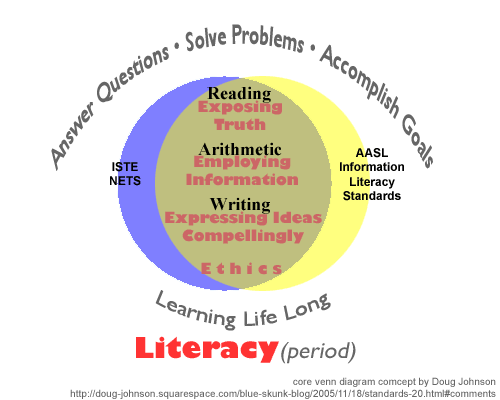It’s a holiday here, but one of the real problems with working out of your home is that it is difficult to find the line between the too. That such incredibly exciting things are going on in your field makes it even harder. The kids are still in bed anyway.
 There has been a lot of talk about information skills and technology skills and how they apply to learning, especially to life-long learning and staff development. Jeff Utecht, of Shanghai, took all of this into an interesting direction when he loaded the ISTI NETS into his word processor, did a global search and replace, and changed all references of technology to information. Read NETS in the 2.0 World in his blog, Thinking Stick. Doug Johnson (The Blug Skunk Blog) of Minnesota, picked up the ball from his library media perspective, and through this convergence, melding the AASL Information Literacy Standards, illustrating it with the Venn diagram to the right. Read Standards 2.0.
There has been a lot of talk about information skills and technology skills and how they apply to learning, especially to life-long learning and staff development. Jeff Utecht, of Shanghai, took all of this into an interesting direction when he loaded the ISTI NETS into his word processor, did a global search and replace, and changed all references of technology to information. Read NETS in the 2.0 World in his blog, Thinking Stick. Doug Johnson (The Blug Skunk Blog) of Minnesota, picked up the ball from his library media perspective, and through this convergence, melding the AASL Information Literacy Standards, illustrating it with the Venn diagram to the right. Read Standards 2.0.
Within the context of this discussion, I described, in OK, No More Staff Development, a desire for teachers to learn to live with less staff development and more self development, and listed a number of conditions that must exist in order for teachers to teach themselves new skills and knowledge for being ever adaptive and life-long learning teachers.
I avoided, however, going to the core of what teachers must have in order to be self-developers, and it’s what Chris Harris, Doug Johnson, Jeff Utecht, Will Richardson, Marco Polo, Chris Lehmann, and other have been talking about — Literacy(period).
Latest year, I keynoted the North Carolina Educational Technology Conference (NCETC) [getting this blog into the ncetc aggregator] with an address called, Redefining Literacy for the 21st Century. In this address, and a corresponding book, I try to expand our notions of
- What it means to be a reader, when information is increasingly networked.
- What it means to be a processor of information, when information is increasingly digital .
- What it means to be a communicating when information overwhelms our listeners’ senses.
- ..and the ethics of living in an information driven culture.
What I’d like us to say is that there is one literacy (Contemporary Literacy) that encompasses all the basic skills involved in using information, and information and communication technologies. I think that if we could agree that this literacy is what and how our students must learn, and assess learning authentically based on this broader sense of basic skills, then we’ll be on a better path to education reform and better preparing our children for the 21st century.
Here’s a diagram. I can resist the temptation to map out the information.


The only additional thing I’d add is that if the teachers don’t have these contemporary literacy skills, the teachers can’t give these contemporary literacy skills…and important realization that I came to through reading your stuff and mixing it with to other parts of the conversation over time.
What a great idea! It is amazing to check out the differences in NETS by such a simple (but illuminating) change. Seems like the problem is that we spend too much time having conversations with teachers about “technology” and not enough time discussing “information”.
Teachers should learn the basic skills of literacy in regard to the different elements of communication. Learning how to communicate with students effectively with technology will also help teachers develop confidence with technology. This might also change negative attitudes about technology into positive attitudes.